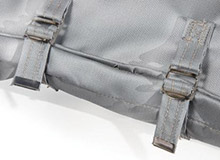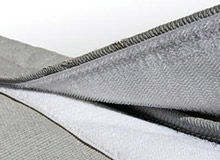Removable Thermal Insulation Covers
Removable thermal insulation covers are used to cover valves, flanges, instrumentation panels, and other components, as well as process piping. Unlike permanent hard insulation, soft insulation covers have the advantage of being removable and reusable, making them the insulation of choice for components that need to be accessed from time to time for maintenance and inspection.
While removable thermal insulation covers are typically one of the last items to be installed before a facility goes into production, they are a critical component when it comes to site safety and system stability.
Valves, flanges, and other components left uncovered can result in:
- Unnecessary process adjustment due to heat loss.
- False readings or alarms being sent to the control room.
- Equipment failures due to operation outside of normal temperature ranges.
- Degradation of product quality due to improper process temperatures.
Process piping and equipment left without a properly designed thermal insulation cover can freeze and fail to properly operate.
Benefits of Removable Insulation Covers
- Heat retention and freeze protection.
- Personnel protection against burns from hot components.
- Energy savings from reduced heat loss to surrounding environment.
- Sound attenuation.
- Insulation is easily removed and replaced to allow for maintenance and inspection.
How Are They Constructed?
Removable insulation covers are typically constructed in 3 layers1. The table and photos below illustrate the construction and materials used in a standard removable insulation cover. Note that for more demanding and unique applications Firwin offers a wide range of alternative materials and construction.
| Layers | Material | Temperature Limit | Function | |
| Outer | Silicone Impregnated Fiberglass | Grey: 500º F (260º C) | Protective Cover | |
| Teflon Coated Fiberglass | Grey: 550º F (287º C) | |||
| Middle | Fiberglass | Firwin 1200: 1200º F (649º C) | Insulation Media (1 Inch)2 | |
| Inner | Silicone Impregnated Fiberglass | Grey: 500º F (260º C) | Contains Insulation Media | |
| Teflon Coated Fiberglass | Grey: 550º F (287º C) |
- Certain applications may require alternative construction methods – i.e. an extra layer may be added, as in the case of sound or fluid barriers.
- One Inch insulation suffices for most applications; however, thickness can be varied based on particular application requirements.
Most Thermowrap blankets are designed for applications under 500°F / 260°C; however alternative insulation materials are available for temperatures ranging from below zero all the way up to 2100°F+. Fastening methods include straps, lacing wire, cords, buckles, and Velcro.
Thermowrap blankets feature high temperature sewn construction and incorporate flaps, closures, and cutouts to provide easy access to ports and controls.
Removable Thermal Insulation Cover Manufacturing Capabilities
- Function
Heat/Energy Conservation
Heat Retention / Maintenance
Personal Protection
Sound Attenuation
- Construction
High Temperature Sewn Construction
- Fastening Methods
Straps
Lacing Wire
Draw Cords
Buckles
Velcro
- Design Features
Flaps
Closures
Cutouts
- Layers
Outer
Middle
Inner
- Outer Cover
Silicone Reinforced Fiberglass
Teflon Reinforced Fiberglass
- Inner Layer / Hotface
Varies Depending on Temperature
- Environments
High Heat
Caustic Substances
Cold (Subzero)
- Temperature Limit
Subzero all the way to 2100°F+
- Insulation Thickness
Typically ½ in. to 2 in.
- Manufacturing Process
CAD / 3D Modeling
Automated Cutting
Sewn
- Additional Services
Field Measurement
Field Installation
Project Management
Private Labeling
- Production Volume
Prototype to Large Runs
- Typical Lead Time
2 to 3 weeks
Rush Service Available
- Intended Applications
Valves
Flanges
Vessels
Manways
Panels
Pumps
Tanks
Turbines
- Certifications
ISO 9001:2015





